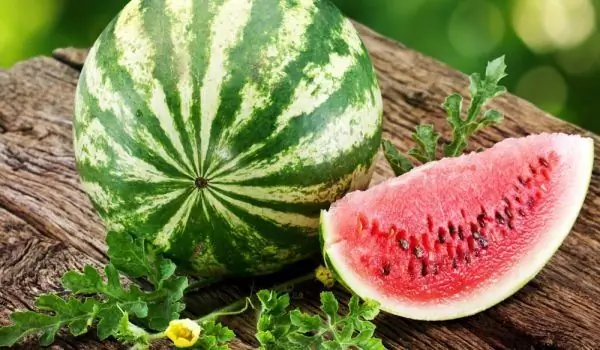2025 Author: Jasmine Walkman | [email protected]. Last modified: 2025-01-23 10:18
Diseases of watermelons are divided into several subspecies:
Bacterial diseases of watermelons - Because bacteria are single-celled plant microorganisms devoid of chlorophyll and plastids, they feed on ready-made organic substances that are absorbed through cell walls by osmosis. They develop in plant tissues, where they reproduce. They lead to a number of problems and harmful formations. They are spread en masse through insects, plant parts, water and air.
- bacterial blight (angular spots) - This bacterium overwinters in plant debris. The seeds are able to keep up to 2-3 years. Symptoms appear on the leaves - small watery angular spots appear, limited by the ribs, at first dark green, later the tissue in the spots burns and falls off. The fruits are also affected, they become small and watery, and the damage spreads inward like wet rot, reaching the seeds and infecting them.
Viral diseases of watermelons - They do not have their own metabolism and develop in the living cell of plants, thus destroying its normal activity and causing mosaic layers. There are several:
- ordinary cucumber mosaic - This virus overwinters in the embryo of the plant, and symptoms of its presence appear only 6-8 weeks after germination. The leaves grow small and mosaic-gray. The virus contains over 60 species of aphids. The solution is to systematically fight them so that you can still enjoy juicy and large watermelons;

- green English mosaic - In it the leaves are again gray, wrinkled, with bubbly bumps. It is spread mainly through irrigation water and seeds, and, having already appeared, it is transmitted from diseased plants to healthy ones.
Fungal diseases of watermelons - These lower chlorophyll-free organisms grow on organic matter synthesized by other organisms. When they use living food for food, they are parasites, and when they eat dead food, they are saprophytes. They reproduce sexually or by spores.
- powdery mildew - Po watermelon leaves small spots appear, covered with a white powdery coating, which over time grow, merge and the leaves look as if sprinkled with flour. All affected leaves fall off;
- mana (Cuban mana) - Chlorotic spots limited by the ribs appear on the upper side of the leaves, and a loose violet-gray deposit is formed on the lower side. Over time, the spots grow, merge, and the leaves burn;
- Fusarium wilt - This fungus affects the root hairs of watermelons in which it is cut. Therefore, the whole plant dries up;
- anthracnose - Affects the leaves and watermelon stems. Spots appear on them, which grow rapidly, and the affected area withers;

- Alternaria - Most often in humid weather and high temperature, small round yellow-brown spots with a whole center appear on the leaves, which grow and form as indentations. On the upper side of the leaf they are seen as rings, and on the fruits the spots are covered with a black-colored dusty mass;
- Scabies - This disease is typical of all pumpkin plants. Symptoms and signs are observed on the aboveground organs. Round or irregular brownish watery spots with a yellow wreath around them develop on the leaves, leaf stalks and the top part of the stems. The fruits of the watermelon are also affected, and in case of early infection the spots grow, the skin cracks and a brown sticky liquid leaks out. The spots form ulcers having a crater-like shape.
Recommended:
Varieties Of Watermelons

Watermelon is an extremely favorite and beloved fruit vegetable in our country. There is almost no person who can resist a piece of juicy watermelon in the summer. There are several main varieties in Bulgaria, but a selection is being made for new ones, as foreign species are being imported and tested.
Emphasize Watermelons And Melons This Summer

In the summer on the Bulgarian market there is an extremely large selection of fruits - the most preferred during the season are watermelons and melons. Slightly chilled, these fruits are a great way to save yourself at least a little from the summer heat.
Greek Watermelons Flood The Home Markets

It is almost impossible to buy Bulgarian watermelons from the markets in our country, as most of the summer fruits are imported from Greece. Bulgarian producers blame the rain for the lack of Bulgarian watermelons. Apart from the fact that the production is extremely low this year, the native farmers also face great difficulties with the competition from the Greek side, because the fruits from our southern neighbor are offered at lower prices than the domestic production.
The First Bulgarian Watermelons Are Already On The Market. Don't Buy Them

The first production of Bulgarian watermelons is already available in our country, but according to the producers they are not bought, as they are offered at slightly higher prices than the imported ones. The trade network is already flooded with Greek and Macedonian watermelons, which have seriously reduced the value of summer fruits, so that Bulgarian farmers are unable to market their production, bTV reports.
Massage The Point Of A Hundred Diseases To Save You From Many Diseases

This point is considered one of the most important. To the east of the village point therapy not only sick people are massaged, but also healthy ones in order to prevent diseases and gain longevity. A Japanese legend says that in ancient times there lived a happy man who received invaluable knowledge from his father - the knowledge of the point of longevity or the point of a hundred diseases .

